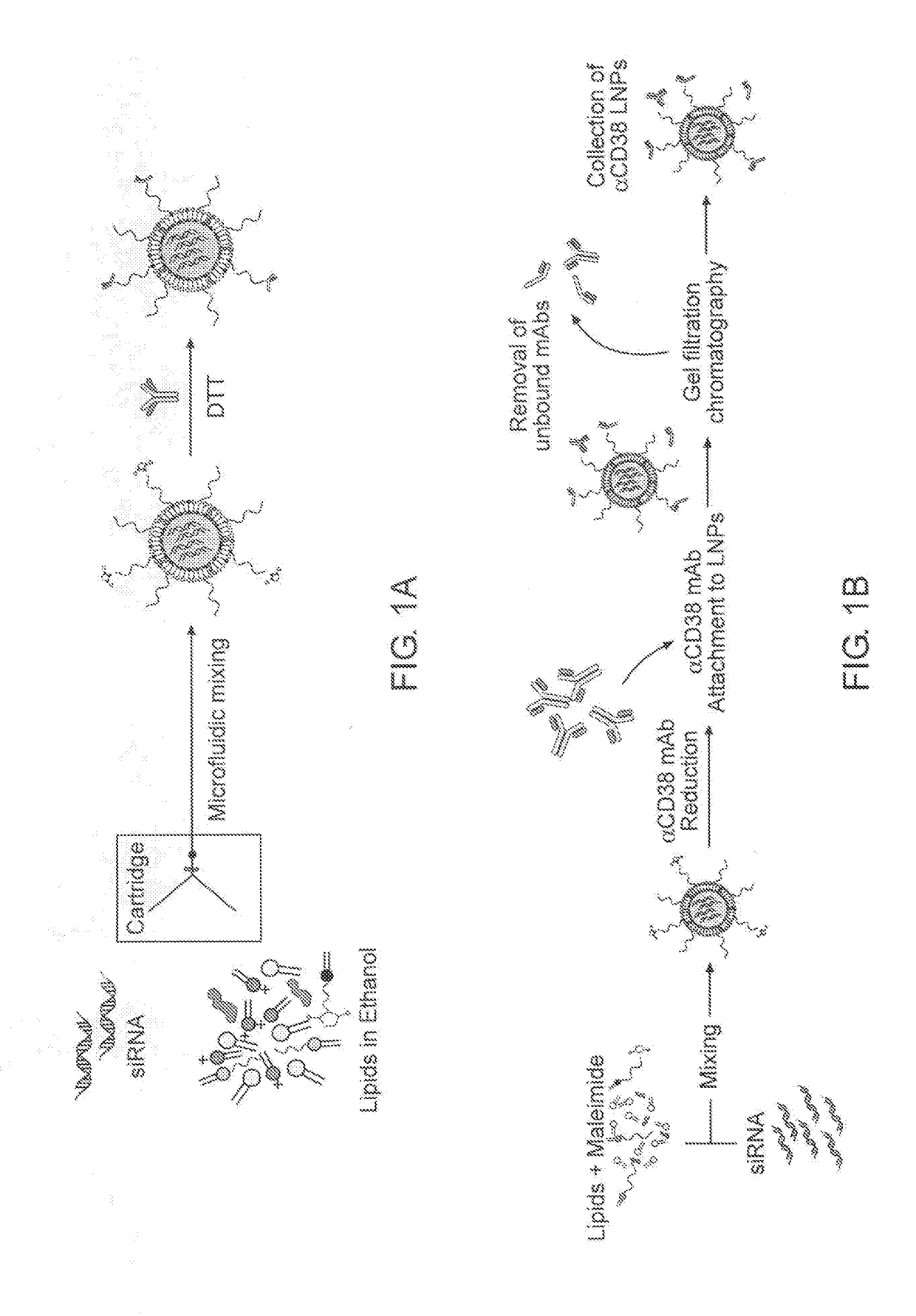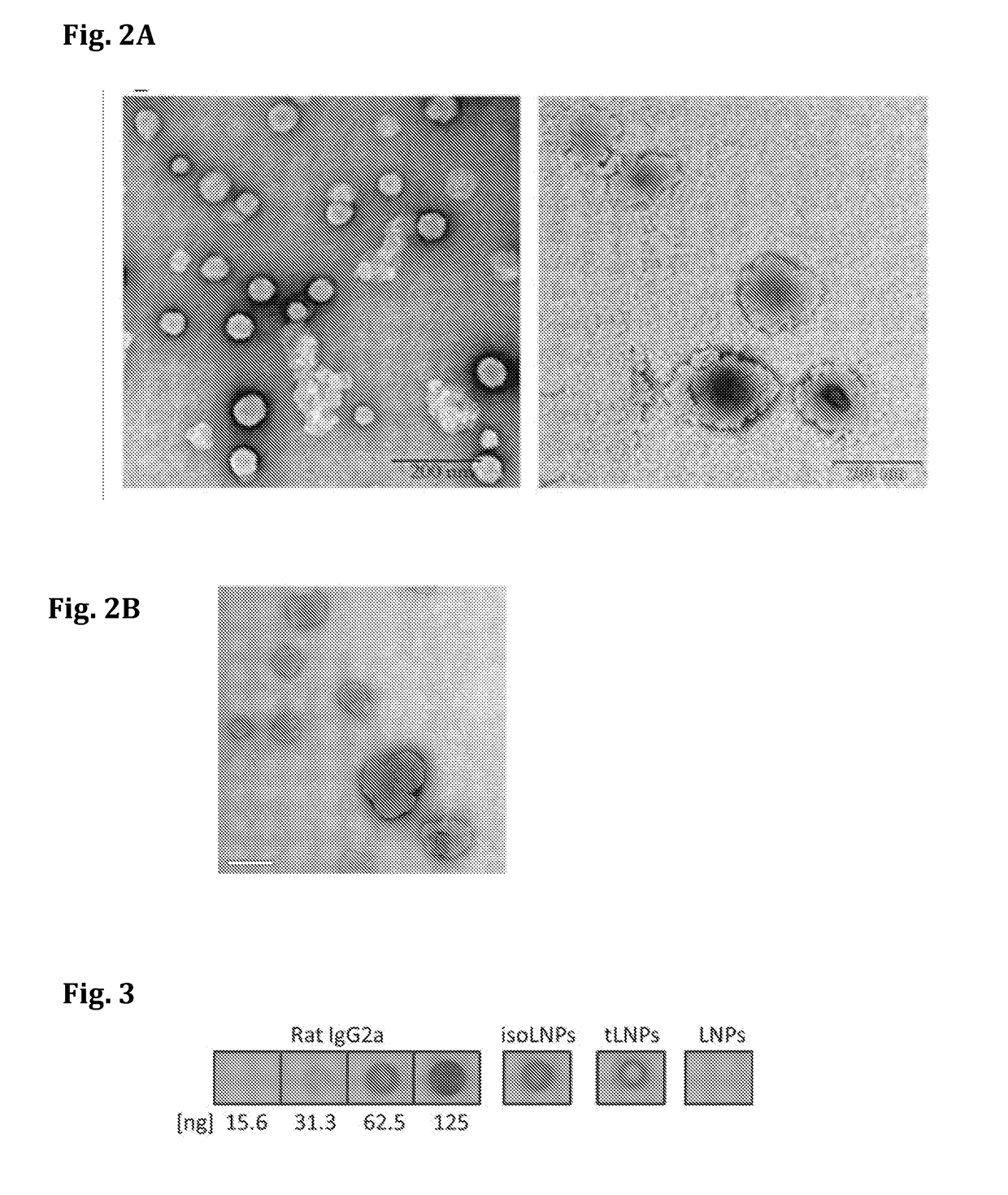Targeted lipid particles for systemic delivery of nucleic acid molecules to leukocytes
- Summary
- Abstract
- Description
- Claims
- Application Information
AI Technical Summary
Benefits of technology
Problems solved by technology
Method used
Image
Examples
example 1
Preparation and Characterization of Targeted-Lipid Nanoparticles (tLNPs), Targeted to T-Cells
[0201]To prepare the effective siRNA delivery system for T cells, which include siRNA-encapsulated LNPs a microfluidic mixer system (Nanoassemblr) was used. The particles were prepared as detailed above. The mixing of acidified siRNAs (pH 4) with a mixture of lipids (cholesterol, DSPC, PEG-DMG, Dlin-MC3-DMA and DSPE-PEG-maleimide; illustrated in FIG. 1), resulted in the production of highly uniform-sized nanoparticles (NPs) that had a mean diameter of ˜58 nm measured by dynamic light scattering (DLS). Since the pKa of Dlin-MC3-DMA lipid is 6.44, it is expected to provide a minimal or neutral charge at physiological pH (7.4) and indeed the zeta potential of the LNPs was shown to be about −9 mV (Table 1). The particles hydrodynamic diameter was also confirmed using transmission electron microscopy (TEM), as shown in FIG. 2 (left hand panel). To construct T-cells targeted LNPs (tLNPs), DTT redu...
example 2
Preparation and Characterization of Targeted-Lipid Nanoparticles (tLNPs), Targeted to B-Cells (MCL Cells)
[0203]Lipid-nanoparticles (LNPs) encapsulating siRNAs using a microfluidic mixing system as described were constructed (FIG. 1B). The lipid mixture included the lipid Dlin-MC3-DMA (50 mol %), cholesterol (38%), DSPC (10%), DMG-PEG (1.95%) and DSPE-PEG-Maleimide (0.05%). αCD38 mAb (clone THB-7) was reduced to allow its chemical conjugation to maleimide groups present in the LNPs and then incubated with the LNPs. The αCD38-LNPs-siRNA had a mean diameter of ˜116 nm with a narrow size distribution (PDI˜0.157) as measured by dynamic light scattering (DLS, Table 2). ζ-potential measurements showed a slight negative surface charge, as expected, at physiological pH (21). Transmission electron microscopy (TEM) analysis of the LNPs indicated a globular shape and size distribution in accordance with the DLS measurements (FIG. 2B).
TABLE 2Characterization of αCD38-LNPs-siRNA by dynamic lights...
example 3
Specific Binding of tLNPs to CD4+ T Cells Ex Vivo
[0204]For the siRNA to be delivered to the cell, the targeting moiety should induce internalization of the nucleic acid encapsulated within the particles. To test whether tLNPs can mediate specific targeting of siRNA to CD4+ cells and induce internalization, tLNPs or LNPs coated with an isotype control mAb (isoLNPs) encapsulating Cy5 labeled-siRNA (siCy5) were used to treat a heterogeneous population of primary C57BL / 6 splenocytes ex vivo. To measure binding to the target cells, tLNPs (siCy5) or isoLNPs (siCy5) were incubated with heterogeneous population of splenocytes, and analyzed by flow cytometry. As shown in FIG. 4A, significant and robust binding to CD4+ cells was observed for tLNPs ((orange) dots; right upper quartet) treated mice, while no significant binding was observed for isoLNPs treated mice (grey dots; upper left quartet). Non-specific binding to either CD8+ cells or B cells (left lower quartet) for mice treated tLNPs / i...
PUM
| Property | Measurement | Unit |
|---|---|---|
| Fraction | aaaaa | aaaaa |
Abstract
Description
Claims
Application Information
 Login to View More
Login to View More - R&D
- Intellectual Property
- Life Sciences
- Materials
- Tech Scout
- Unparalleled Data Quality
- Higher Quality Content
- 60% Fewer Hallucinations
Browse by: Latest US Patents, China's latest patents, Technical Efficacy Thesaurus, Application Domain, Technology Topic, Popular Technical Reports.
© 2025 PatSnap. All rights reserved.Legal|Privacy policy|Modern Slavery Act Transparency Statement|Sitemap|About US| Contact US: help@patsnap.com



